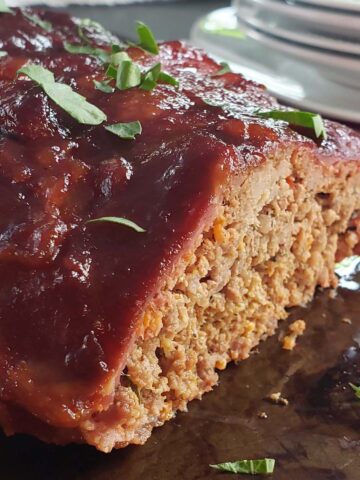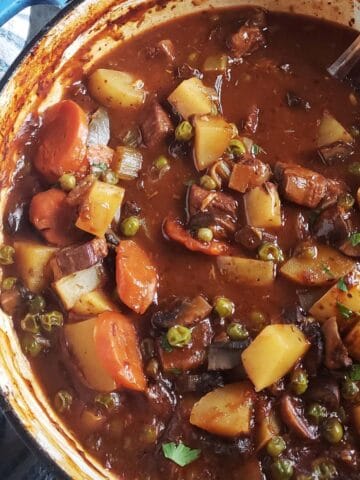Everything you need to know about freezing beef stew. Learn how to freeze a batch of beef stew without freezer burn and without losing flavor.
Beef stew is classic comfort food and is typically a combination of beef cubes and vegetables served in a delicious beef broth flavored with herbs and spices. What happens if you cook too much stew? What can you do with leftover beef stew?
Like many homemade soups and stews beef stew actually tastes better the following day, which makes it a great make-ahead meal. Frozen stew is one of my favorite meals to have saved in the freezer for busy days.
One of my other favorite meal shortcuts is frozen smoked pulled pork. Check out my blog post on How to Store and Reheat Pulled Pork for even more information.
This is my recipe for my favorite Dutch Oven Beef Stew. I also recommend trying this Winter Pork and Sweet Potato Soup.

Jump to:
When stored properly beef stew will typically last in the freezer for up to three months.
The next time you make your favorite beef stew recipe why not double it so that you have extra to freeze for another meal?
Ingredients
Beef stew can be prepared with a variety of ingredients.
If you are preparing a stew specifically for freezing the general rule is to leave certain ingredients out because they can affect how well a stew freezes.
Thickeners: It is best to not add a thickening agent before freezing stew. When frozen thickeners like flour or cornstarch can separate.
It is best to thicken the stew when you reheat it.
Potatoes: Potatoes generally do not freeze very well. When frozen potatoes break down and turn into mush.
It is best to boil and add the potatoes when you reheat the stew.
Pasta and Rice: Cooked pasta and rice also do not freeze well and tend to become mushy once they have been frozen and defrosted. It is best to add these ingredients once the stew has been reheated.

Directions
Freeze your beef stew in just a few simple steps.
For the best results, the first step is to allow the cooked beef stew to cool to room temperature.
I will then often refrigerate the stew and freeze it the next day. When freezing a pot of beef stew you want it to freeze as quickly as possible.
Freezing quickly minimizes the number of ice crystals that form and degrade the texture of the stew. A stew that freezes at a chilled temperature will freeze faster than a stew at room temperature.
Transfer the stew to zip-top freezer bags or airtight containers.
To make pouring stew into a heavy-duty freezer bag easier you may want to purchase these bag holders. They are great at holding freezer bags open while you pour the stew in.
It is important to remove as much air from the bags as possible to help prevent freezer burn.
To remove excess air, zip the bag almost completely closed, then insert a straw at the corner of the bag, suck out the extra air, remove the straw, and finish zipping the bag closed.

Label with the contents and date. If you are freezing meals frequently you may want to pick up some of these freezer labels to make organizing your freezer easier. Labeling your food will help you to know what it is and when it should be used by.
Once different foods are frozen they can look surprisingly similar.
If you don't have freezer labels, the best option is to use a permanent marker and masking tape.
Tip: When freezing stew in freezer bags I like to lay the bag flat in the freezer. This makes storage easier and allows the stew to defrost more quickly and evenly due to the increased surface area.
How to Thaw Beef Stew
To thaw beef stew place the container in the refrigerator and allow it to thaw overnight.

If the stew was frozen in a freezer bag, I recommend placing the bag in a bowl or shallow tray just in case the bag leaks during the defrosting process.
To thaw beef stew even more quickly, place the stew in a bowl filled with cold water. Dump the cold water out and replace it with fresh cold water every thirty minutes until the stew has thawed completely.
How to Reheat Stew
You have a couple of options for reheating leftover stew.
Reheating Stew in the Microwave
The microwave is a great way to heat up an individual portion of stew.
Microwaves heat at different rates. The time needed to heat beef stew will vary depending on the strength of your microwave.
Place the stew in a microwave-safe container.
Microwave the stew on high for 2-3 minutes.
Remove the stew from the microwave and stir it to help it cook evenly.
Cook for an additional minute or two if necessary.
To prevent splatters, cover the bowl with a microwave-safe cover.

Reheating Stew on the Stove Top
This is the best way to reheat enough stew to serve multiple people.
Add stew to a large saucepan and reheat over medium heat
Stir occasionally until the stew has been heated through.
If the stew seems a bit dry you can add a few tablespoons of water or beef stock.
Reheating Stew in the Slow Cooker
Reheating stew in a slow cooker is not advisable because the stew spends too much time at a low temperature which encourages bacterial growth.
Frequently Asked Questions
Yes. If you have leftover beef stew that you know you can't eat before it spoils go ahead and freeze it.
Potatoes do tend to become mushy once they have been frozen but not to the extent that they will ruin your stew once you defrost and reheat it.
If you are making stew specifically to freeze for a quick and easy freezer meal, you can wait to add the potatoes until you are reheating the stew. Simply boil the potatoes until they are tender and then add them to the reheated stew.
In an airtight container frozen beef stew has a shelf life of about three months.
I do not recommend refreezing beef stew. Multiple freezings and defrostings will cause texture and flavor changes to the stew.
The best way to determine if beef stew has gone bad is to smell and look at it. Signs beef stew has gone bad include a sour smell, dull color, or slimy texture.
Discard any beef stew with an off smell or appearance.

Tips
- Let the beef stew cool completely to room temperature before freezing.
- Keep your freezer organized and eliminate mystery containers by labeling your storage container with the contents and the date before freezing.
- When freezing stew in a rigid freezer container, be sure to leave a little head space. Do not fill the container to the very top. As the stew freezes it will expand in volume slightly.
- For a quick and easy meal for one, freeze the stew in individual portions using a smaller container.
Related
Looking for other recipes like this? Try these:











Comments
No Comments